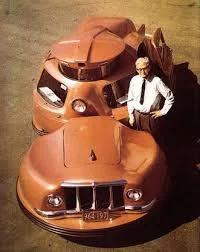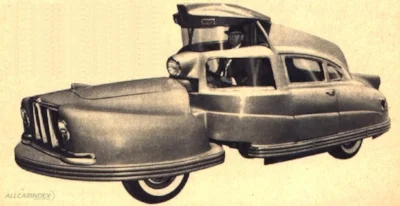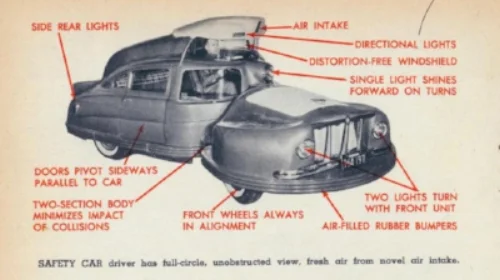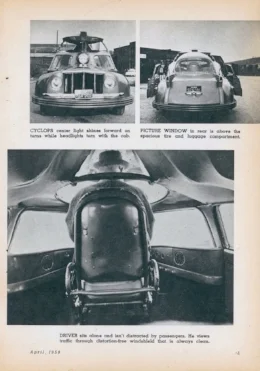The Sir Vival: America's First Safety Car
/The story of the Sir Vival safety car begins as the 1950s were winding down. The previous dozen years had been a time of great optimism and prosperity in America. The economy was expanding rapidly, and the automobile was in full ascendancy. Motorists were traveling as never before. Not only were many more cars on the road but they were bigger and faster, and designed to travel great distances on the nation’s sparkling new interstate highway system. Volume, speed, weight and distance – these factors had led to a horrifying but inevitable explosion in traffic fatalities. Since September 13, 1899, when a New York City real estate developer named Henry Hale Bliss died after being struck by an electric taxicab at the corner of 74th and Central Park, thus becoming the worlds’ first documented automobile traffic fatality, a cumulative million people had lost their lives in car accidents. Each day hundreds more were dying or being maimed. In the eyes of many, such carnage could not continue.
www.oldcarconcepts.com
Enter one Walter C. Jerome, an engineer and tinkerer from Waltham, Massachusetts, a man who made it his mission to put an end to the slaughter. Like a knight called to a righteous quest, Jerome set out to defeat death on the American road. The battle horse on which Sir Jerome would ride forth was a safety car of his own design called the Sir Vival.
Upon first encounter with the Sir Vival, its visual inputs strike us with alarming force. Our initial impulse is to call the authorities, because clearly a Chinese New Year parade has seen one of its dragon floats broken lose. As our brains begin to process the horde of conflicting information being presented, the Sir Vival’s numerous firsts in the name of safety (and gratefully lasts) begin to take form.
The most pronounced of these is the insect-like two section body. The rear half appears to have once been a ’48 Hudson, while the origins of the front is anyone’s guess. Jerome’s thinking here was that in the event of a head-on collision, the front section containing the engine would pivot, diverting energy away from the rear section which holds the passengers.
The next sight to behold is the turret-like dome rising from the aft section, much like the bridge of a spaceship in a period Sci-Fi movie. Indeed, this does contain the Sir Vival’s cockpit. Jerome’s logic behind the layout was two-fold. The driver is elevated for maximum visibility, as well as being separated from the passengers in order to reduce distractions.
But wait, there’s more. Surrounding the entire perimeter of the car are rubber bumpers filled with air meant to absorb impact. Protruding from the front of the aft section, just below the elevated cockpit, is a giant cyclops’ headlight that shines straight ahead as the two normal headlights on the front section turn with the front wheels. This setup was meant to provide more complete illumination in the corners. The doors pivot sideways, and then open parallel instead of out. This is to make sure they don’t fly open in a crash. Finally, the whole passenger compartment is protected by a steel safety cage.
Could the great Dr. Seuss come up with a more imaginative machine?
Mechanics Illustrated April 1959
The promise of traversing the nation’s highways and bi-ways in blessed safety: Surely a carnage-weary populous would clamor for the Sir Vival’s noble services. With such hopes in mind, Walter Jerome brought his creation to the 1959 World’s Fair Transportation & Travel Pavilion in New York, where he hoped to collect sufficient orders to get his safety car into mass production. Alas, no buyers were forthcoming. One reason (among the many) was that the Sir Vival carried a $10,000 price tag - a quarter that of the average American car at the time. It seems immortality is not priceless after all.
www.kustomrama.com
Jerome would not give up the good fight so easily. He still held patents on some of his numerous and unique safety features. He presented them individually to various manufacturers. Shockingly, none were interested in bi-sectional construction or cockpit turrets.
After that, Sir Jerome called it a quest and went home.
As it turns out, Walter Jerome’s timing (like his aesthetics) were a bit off. A half dozen years later, that better known crusader for consumer protection, Ralph Nader in his seminal book, Unsafe at Any Speed, made automotive safety a priority, and its eventual regulation a reality.
And what of the car? Of course it sir-vived. It’s a safety car after all. The one Sir Vival ever made resides at last report in a private collection in Bellingham, Mass.
www.MotoringNews.com
Copyright@2021 by Mal Pearson






